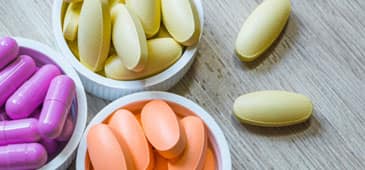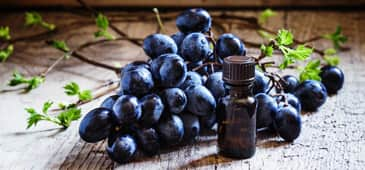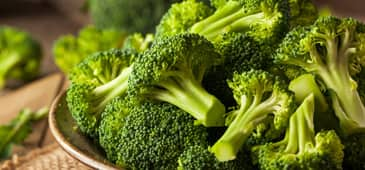
What's hot
What's hot
News flashes are posted here frequently to keep you up-to-date with the latest advances in health and longevity. We have an unparalleled track record of breaking stories about life extension advances.
Greater magnesium intake from food and supplements associated with decreased fracture risk
 June 30 2017. A study reported on June 20, 2017 in the British Journal of Nutrition provides a link between increased intake of magnesium and a lower risk of developing a fracture over an 8-year follow-up period.
June 30 2017. A study reported on June 20, 2017 in the British Journal of Nutrition provides a link between increased intake of magnesium and a lower risk of developing a fracture over an 8-year follow-up period.
The investigation included 1,577 men and 2,071 women enrolled in the Osteoarthritis Initiative, an ongoing, multicenter, longitudinal U.S. study. Questionnaires completed upon enrollment provided data concerning magnesium intake from supplements and diet. Only 27% of the subjects had an intake of magnesium that met the U.S. recommended daily allowance (RDA) of 420 milligrams (mg) for men and 320 mg for women.
Over an 8-year follow-up period, 198 men and 368 women developed a fracture. Men whose intake of magnesium was among the top 20% of subjects had a 53% lower adjusted risk of fracture in comparison with those whose intake was among the lowest 20%, and for women, the risk experienced by those among the top intake category was 62% lower. Women whose intake of magnesium met the U.S. RDA had a 27% lower risk of fracture than those who failed to consume this amount.
As potential mechanisms, Nicola Veronese and colleagues observe that magnesium positively influences osteoblast and osteoclast function, and plays a role in the modulation of calcium homeostasis via its contribution to calcitriol and parathyroid regulation. Magnesium also helps combat inflammation which is associated with fracture and osteoporosis, and contributes to muscle strength, thereby reducing the risk of falls.
"Higher dietary magnesium intake has a protective effect on bone osteoporotic fractures, particularly in women, suggesting an important role of this mineral in osteoporosis and fractures," the authors conclude. "Further randomized controlled trials are needed to understand the possible role of magnesium in delaying fractures."
—D Dye
Vitamins, steroid could prevent sepsis-associated death
 June 28 2017. The June 2017 issue of the journal CHEST reports the finding of a benefit for intravenous thiamin (vitamin B1), vitamin C and the steroid hydrocortisone in prevention of organ failure and death in patients with septic shock, a condition characterized by low blood pressure and cellular metabolism abnormalities that occurs in response to infection.
June 28 2017. The June 2017 issue of the journal CHEST reports the finding of a benefit for intravenous thiamin (vitamin B1), vitamin C and the steroid hydrocortisone in prevention of organ failure and death in patients with septic shock, a condition characterized by low blood pressure and cellular metabolism abnormalities that occurs in response to infection.
"New therapeutic approaches to sepsis are desperately required," remarked lead investigator Paul E. Marik, MD, who is the Chief of Pulmonary and Critical Care Medicine in the Department of Internal Medicine at Eastern Virginia Medical School in Norfolk. "Our results suggest that early use of intravenous vitamin C, together with corticosteroids and thiamine may prove to be effective in preventing progressive organ dysfunction, including acute kidney injury, and reducing the mortality of patients with severe sepsis and septic shock."
The retrospective study compared 47 patients with sepsis who were seen in a hospital intensive care unit during a 7-month period with 47 patients who received standard care plus the vitamin and corticosteroid combination during a subsequent 7-month period. While in-hospital mortality was 40.4% among the control group, only four (8.5%) of those who received the intravenous vitamin treatment died. No deaths among those who received the therapy were due to sepsis but were, rather, caused by underlying conditions.
"We did not test an expensive, proprietary designer molecule, but rather a combination of three cheap and readily available agents with a long safety record in clinical use since 1949," Dr Marik noted. "Due to the inherent safety of the combination of hydrocortisone, vitamin C, and thiamine, we believe that this treatment strategy can be adopted pending the results of further clinical trials. This inexpensive intervention has the potential to reduce the global mortality for sepsis."
—D Dye
Systolic blood pressure reduction associated with lower mortality risk during 3.7 year average follow-up
 June 26 2017. A review and meta-analysis published on May 31, 2017 in JAMA Cardiology concluded that lowering systolic blood pressure below recommended targets was associated with a significant reduction in the risk of cardiovascular disease and mortality from all causes during up to 8 years of follow-up.
June 26 2017. A review and meta-analysis published on May 31, 2017 in JAMA Cardiology concluded that lowering systolic blood pressure below recommended targets was associated with a significant reduction in the risk of cardiovascular disease and mortality from all causes during up to 8 years of follow-up.
Joshua D. Bundy and colleagues selected 42 trials that included a total 144,220 participants for their review. Trial subjects were randomly assigned to receive a blood pressure-lowering medication, a control substance or a treatment target. The duration of the trials ranged from 6 months to over 8 years, with an average length of 3.7 years.
Groups that achieved an average systolic blood pressure of 120 to 124 mmHg had a 29% lower risk of cardiovascular disease in comparison with those that achieved an average systolic pressure of 130 to 134 mmHg. When compared to groups that achieved systolic pressures of 140-144 mmHg, 150-154 mmHg, and 160 mmHg or higher, the reduction in risk associated with achievement of 120 to 124 mmHg was respectively 42%, 54%, and 64% lower.
The risk of mortality from any cause over follow-up was 27% lower among those whose systolic blood pressure was reduced to 120-124 mmHg compared with groups that achieved 130 to 134 mmHg, 41% lower when compared to those who achieved 140 to 144 mmHg, 49% lower than those who achieved 150-154 mmHg and 68% lower than participants whose average systolic blood pressure was 160 mmHg or higher.
“Finding the optimal systolic blood pressure target could have far-reaching implications for the reduction of cardiovascular and premature death in general populations,” Dr Bundy and colleagues write. “These findings support more intensive control of systolic blood pressure among adults with hypertension.”
—D Dye
Most occupations carry risk of vitamin D deficiency
 June 23 2017. The journal BMC Public Health reported a significant risk of vitamin D deficiency and insufficiency among workers in a variety of occupations. The findings were published on June 22, 2017.
June 23 2017. The journal BMC Public Health reported a significant risk of vitamin D deficiency and insufficiency among workers in a variety of occupations. The findings were published on June 22, 2017.
By reviewing 71 articles that included a total of 53,425 subjects, Sebastian Straube and colleagues determined that the highest risk of deficiency occurred among shift workers, whose incidence of vitamin D deficiency was 80%. Indoor workers had the second highest incidence at 77%.
Ironically, healthcare students experienced the third highest risk. Sixty-five percent of medical residents, 46% of practicing physicians, 43% of nurses and 43% of other healthcare professionals were deficient in vitamin D.
In addition to deficiency, vitamin D insufficiency was also common. Ninety-one percent of indoor workers and 75% of outdoor workers had insufficient levels of the vitamin. Although vitamin D is formed in the skin in response to ultraviolet light exposure, 48% of outdoor workers were still vitamin D deficient. "Vitamin D production by the body is reliant on sunshine and UV exposure so any activity that reduces exposure tends to reduce vitamin D levels,” Dr Straube observed. “Sunlight deprivation in young medical professionals, who may have particularly long working hours, and other indoor workers, puts them at higher risk of both vitamin D insufficiency and deficiency."
"Our results suggest that occupation is a major factor that may contribute to suboptimal vitamin D levels,” Dr Straube concluded. “Regular screening of vitamin D levels in at-risk groups should be considered for future clinical practice guidelines and public health initiatives. Workplace wellness programs could include education about the importance of adequate vitamin D levels. This could help prevent adverse health outcomes linked to vitamin D deficiency, such as metabolic disorders, psychiatric and cardiovascular disorders, and cancer."
—D Dye
Grape seed extract, resveratrol show promise against colon cancer
 June 21 2017. Research conducted at Pennsylvania State University indicates that grape seed extract and resveratrol, which occurs in red grapes, can suppress colon cancer stem cells. The study was reported in BMC Complementary and Alternative Medicine.
June 21 2017. Research conducted at Pennsylvania State University indicates that grape seed extract and resveratrol, which occurs in red grapes, can suppress colon cancer stem cells. The study was reported in BMC Complementary and Alternative Medicine.
"We are particularly interested in targeting stem cells because, according to cancer stem-cell theory, cancerous tumors are driven by cancer stem cells," explained coauthor Jairam K.P. Vanamala, who is an associate professor of food sciences at Penn State. "Cancer stem cells are capable of self-renewal, cellular differentiation and maintain their stem cell-like characteristics even after invasion and metastasis."
In human colon cancer stem cell cultures, a combination of resveratrol and grape seed extract suppressed proliferation and other factors in a manner similar to the nonsteroidal anti-inflammatory drug sulindac, which has reduced tumors in humans. In mice with induced colon cancer, resveratrol and grape seed extract suppressed tumor incidence by more than 50%--an effect that was also comparable to that associated with sulindac. The combined effect of resveratrol and grape seed extract was associated with greater cancer stem cell suppression than either compound alone. "This also connects well with a plant-based diet that is structured so that the person is getting a little bit of different types of plants, of different parts of the plant and different colors of the plant," stated Dr Vanamala, who is also a faculty member at the Pennsylvania State University Hershey Cancer Institute. "This seems to be beneficial for not only promoting bacterial diversity, but also preventing chronic diseases and eliminating the colon cancer stem cells."
"The combination of resveratrol and grape seed extract is very effective at killing colon cancer cells," he concluded. "And what we're learning is the combination of these compounds is not toxic to healthy cells."
—D Dye
Broccoli compound could be helpful to diabetes
 June 19 2017. The June 14, 2017 issue of Science Translational Medicine published the finding of an ability for sulforaphane, a compound that occurs in broccoli and other vegetables, to lower the liver’s production of glucose.
June 19 2017. The June 14, 2017 issue of Science Translational Medicine published the finding of an ability for sulforaphane, a compound that occurs in broccoli and other vegetables, to lower the liver’s production of glucose.
By comparing gene signatures for diabetes with the potential ability of 3,852 compounds to affect these genes, Anders Rosengren and colleagues identified sulforaphane as having the highest overlap. “A large number of genetic variants and tissue gene expression profiles (“disease signatures”) have been associated with complex polygenic diseases over the last decade,” the authors explain. “One potentially interesting approach is to use genetic and gene expression data to interrogate libraries of drug signatures. A drug signature denotes differentially expressed genes between untreated and treated samples and takes into account that most compounds have multiple gene effects on expression beyond the primary target.”
In rat liver cells, the administration of sulforaphane was associated with a decrease of glucose production. In rodents with dietary-induced diabetes, sulforaphane decreased excess glucose production and glucose intolerance to a degree comparable to that of metformin. "We tested removing sulforaphane from the extract and the effect disappeared,” Dr Rosengren reported. “We also looked at the genes from the liver of the animals and saw that the 50 key genes had been changed in the right direction."
When tested in a trial of diabetics, broccoli sprout extract significantly improved fasting glucose levels in obese participants who entered the study with dysregulated disease compared to controls.
"There are strong indications that this can become a valuable supplement to existing medication," Dr Rosengren predicted. "Sulforaphane targets a central mechanism in type 2 diabetes and has a mild side-effect profile. As functional food, it can reach the patients faster than a medication, and it is also an interesting concept from a diabetes perspective where diet is central."
—D Dye
Senescent cell removal could help fight aging-related conditions
 June 16 2017. A letter published on April 24, 2017 in Nature Medicine suggests a role for senescent cell removal in combatting conditions associated with aging, including osteoarthritis.
June 16 2017. A letter published on April 24, 2017 in Nature Medicine suggests a role for senescent cell removal in combatting conditions associated with aging, including osteoarthritis.
“Senescent cells accumulate in many vertebrate tissues with age and contribute to age-related pathologies, presumably through their secretion of factors contributing to the senescence-associated secretory phenotype (SASP),” write Ok Hee Jeon of Johns Hopkins University School of Medicine and colleagues. “Removal of senescent cells delays several pathologies and increases healthy lifespan.”
Acting on the observation of senescent chondrocytes in the cartilage tissue of joint replacement surgery patients, Dr Jeon and associates investigated the hypothesis that senescent cells could play a causative role in osteoarthritis. Using a mouse strain that allowed the researchers to track senescent cells in animals that underwent anterior cruciate ligament injury, they observed an accumulation of these cells in the animals’ joint cartilage and synovium. Selectively eliminating the cells reduced the development of posttraumatic osteoarthritis, while increasing cartilage development and decreasing pain. In three types of mice, joint injection of a senolytic compound designated as UBX0101 that selectively killed senescent cells validated the current findings. Additionally, removal of senescent cells from cartilage obtained from osteoarthritis patients who underwent total knee replacement resulted in a decrease in the expression of senescent and inflammatory markers and an increase in the expression of cartilage tissue extracellular matrix proteins.
Dr Jeon and colleagues conclude that the findings support the targeting of senescent cells to treat degenerative joint disease.
—D Dye
Insufficient vitamin A levels could increase TB susceptibility
 June 14 2017. Findings reported on May 20, 2017 in Clinical Infectious Diseases suggest a protective role for vitamin A against the acquisition of tuberculosis (TB) among those living in proximity of infected individuals.
June 14 2017. Findings reported on May 20, 2017 in Clinical Infectious Diseases suggest a protective role for vitamin A against the acquisition of tuberculosis (TB) among those living in proximity of infected individuals.
Subjects in the current study consisted of household contacts of a cohort of individuals with tuberculosis residing in Lima, Peru. Blood samples collected upon enrollment were analyzed for vitamin A and other factors. One hundred eighty subjects who developed TB within a one year follow-up period were matched with 709 control subjects who did not develop the disease.
The researchers found that those whose vitamin A blood levels were deficient at less than 200 micrograms per liter had a ten times higher risk of developing TB compared to those who were not deficient. Among vitamin A deficient subjects between the ages of 10 to 19 years, the risk of developing TB was 20 times higher, which suggests that the vitamin could play a greater role in immunity among younger individuals.
"This is one of the strongest risk factors reported in a large epidemiological study in years," announced senior author Megan Murray, who is the Ronda Stryker and William Johnston Professor of Global Health at Harvard Medical School. "If the link is affirmed in a clinical trial of vitamin A supplementation, it would make a powerful case for using this approach to prevent TB in people at high risk of disease."
"It's exciting to think that something as simple and inexpensive as supplementing people's diets with vitamin A may be a powerful tool for preventing TB," she added.
“TB is a tough disease to live with, and a tough disease to treat," Dr Murray observed. "We'd love to keep people from getting sick in the first place."
—D Dye
Low dose aspirin use associated with reduced breast cancer risk among diabetics
 June 12 2017. A retrospective study reported on May 24, 2017 in the Journal of Women’s Health revealed a decreased risk of breast cancer among women with diabetes who regularly consumed low-dose aspirin. Type 2 diabetes is associated with a higher risk of developing breast cancer and other cancers. Due to the relationship between type 2 diabetes and cardiovascular disease, many diabetics have been advised to use low dose aspirin as a preventive measure.
June 12 2017. A retrospective study reported on May 24, 2017 in the Journal of Women’s Health revealed a decreased risk of breast cancer among women with diabetes who regularly consumed low-dose aspirin. Type 2 diabetes is associated with a higher risk of developing breast cancer and other cancers. Due to the relationship between type 2 diabetes and cardiovascular disease, many diabetics have been advised to use low dose aspirin as a preventive measure.
“This study is the first to discuss whether aspirin reduces the risk of breast cancer in patients with diabetes, a critical topic to address because patients with type 2 diabetes have an increased risk of cancers, including breast cancer, and cancer mortality,” Yi-Sun Yang, MD, PhD, and colleagues at Chung Shan Medical University in Taiwan announce.
Dr Yang and associates analyzed data from Taiwan’s National Health Insurance Database collected from January 1998 through 2011. Among 148,739 diabetics, 27,378 subjects were using aspirin. For the current study, 24,101 aspirin users were matched with an equal number of aspirin nonusers.
Low dose aspirin was defined as 75 to 165 milligrams per day. Among those who reported using aspirin, the adjusted risk of breast cancer was 18% lower compared to nonusers. A high cumulative dose of aspirin, defined as consuming over 88,900 milligrams over an average of 8.5 years was associated with a 47% lower risk.
"Women with type 2 diabetes have an increased risk of breast cancer, and these results suggest that the same low-dose aspirin that many of these women take to prevent cardiovascular disease may also help reduce their risk of breast cancer," commented Susan G. Kornstein, MD, who is Editor-in-Chief of Journal of Women's Health, and Executive Director of the Virginia Commonwealth University Institute for Women's Health.
—D Dye
Coffee, herbal tea may help prevent liver fibrosis
 June 09 2017. Findings reported on June 1, 2017 in the Journal of Hepatology add evidence to a protective effect for coffee and herbal tea against liver fibrosis, a condition characterized by progressive scarring from chronic inflammation, which can lead to the development of cirrhosis.
June 09 2017. Findings reported on June 1, 2017 in the Journal of Hepatology add evidence to a protective effect for coffee and herbal tea against liver fibrosis, a condition characterized by progressive scarring from chronic inflammation, which can lead to the development of cirrhosis.
"There is quite some epidemiological, but also experimental data suggesting that coffee has health benefits on liver enzyme elevations, viral hepatitis, NAFLD, cirrhosis, and liver cancer,” noted lead researcher Sarwa Darwish Murad, MD, PhD, who is a hepatologist at the Erasmus MC University Medical Centre in the Netherlands. “Beyond the liver, coffee has been demonstrated to be inversely associated with overall mortality in the general population. The exact mechanism is unknown but it is thought that coffee exerts antioxidant effects. We were curious to find out whether coffee consumption would have a similar effect on liver stiffness measurements in individuals without chronic liver disease."
The study included 2,424 participants in the Rotterdam Study, which included men and women aged 45 years and older. Dietary questionnaire responses provided information concerning the number of cups of coffee and tea consumed per day. Transient elastography and ultrasound examinations assessed liver fibrosis.
Increased liver stiffness was found in 5.2% of the subjects, however, among those whose coffee intake was categorized as frequent at greater than three cups per day, the percentage of subjects decreased to 4.1%. Among tea drinkers, only herbal tea was associated with a reduction in fibrosis.
Lead author Louise J. M. Alferink, MD, of the Department of Gastroenterology and Hepatology, Erasmus MC University Medical Centre, concluded that "Examining accessible and inexpensive lifestyle strategies that have potential health benefits, such as coffee and tea consumption, is a viable approach to finding ways to halt the rapid increase of liver disease in developed countries."
—D Dye
Curcumin, resveratrol, ursolic acid show promise against prostate cancer
 June 07 2017. An article appearing on June 5, 2017 in the Nature Partners Journal npj Precision Oncology reveals a potential benefit for several plant compounds against prostate cancer.
June 07 2017. An article appearing on June 5, 2017 in the Nature Partners Journal npj Precision Oncology reveals a potential benefit for several plant compounds against prostate cancer.
By screening 142 phytochemicals in a natural compound library and testing varying doses alone or in combination in mouse and human prostate cancer cell lines, researchers at the University of Texas at Austin identified curcumin from turmeric, resveratrol, found in red grapes and other plants, and ursolic acid, which occurs in rosemary and apple peel as having anticancer effects.
The three compounds were subsequently evaluated alone or in combination in mice that had received implanted prostate tumor cells. Tumor volume was monitored beginning on the first day of treatment with the compounds and continued through the thirty-second day. It was found that curcumin or ursolic acid had the greatest anticancer effects, and that ursolic acid also boosted the effects of curcumin or resveratrol. “The in vivo studies provided further evidence that the selected natural compound combinations were highly effective in slowing growth of murine prostate cancer cells,” authors Alessia Lodi and colleagues report.
"After screening a natural compound library, we developed an unbiased look at combinations of nutrients that have a better effect on prostate cancer than existing drugs," commented corresponding author Stefano Tiziani, who is an assistant professor in the Department of Nutritional Sciences and Dell Pediatric Research Institute at the University of Texas Austin. "The beauty of this study is that we were able to inhibit tumor growth in mice without toxicity."
"These nutrients have potential anticancer properties and are readily available," he added. "We only need to increase concentration beyond levels found in a healthy diet for an effect on prostate cancer cells."
—D Dye
Olive oil compound could help protect against brain cancer
 June 05 2017. The June 2017 issue of the Journal of Molecular Biology published the finding of researchers at the University of Edinburgh of a protective effect for oleic acid from olive oil against the development of brain cancer.
June 05 2017. The June 2017 issue of the Journal of Molecular Biology published the finding of researchers at the University of Edinburgh of a protective effect for oleic acid from olive oil against the development of brain cancer.
Working with human cell extracts and cell cultures, Dr Gracjan Michlewski and colleagues determined that oleic acid prevents the cell protein Musashi homolog2 (MSI2) from halting the production of a microRNA known as miR-7, which protects against tumor formation.
“MicroRNAs (miRs) play a vital role in governing cell function, with their levels tightly controlled at transcriptional and post-transcriptional levels,” lead author Santosh Kumar and associates explain. “The Hu antigen R (HuR)-mediated binding of Musashi homolog2 (MSI2) to the conserved terminal loop of pri-miR-7 regulates the levels of brain-enriched miR-7 formation in a tissue-specific manner. Here, we show that oleic acid (OA) inhibits the binding of proteins containing RNA recognition motifs to the conserved terminal loop of pri-miR-7.”
The research team has stated while it is too early to determine whether increasing one’s intake of olive oil could help protect against cancer of the brain, their discovery could aid in the development of preventive therapies.
"While we cannot yet say that olive oil in the diet helps prevent brain cancer, our findings do suggest that oleic acid can support the production of tumor-suppressing molecules in cells grown in the lab,” commented Dr Michlewski, of the University of Edinburgh's School of Biological Sciences. “Further studies could help determine the role that olive oil might have in brain health."
—D Dye
Vitamin D supplements, sleep could help manage pain
 June 02 2017. For patients faced with the choice of using potentially addictive and dangerous prescription drugs or undergoing long-term unmanaged pain, findings reviewed by Brazilian researchers could come as a relief. In an article published in the July 1, 2017 issue of the Journal of Endocrinology, Monica Levy Andersen and colleagues at the Universidade Federal de Sao Paulo’s department of psychology suggest a benefit for sound sleep combined with supplementation with vitamin D for chronic pain management.
June 02 2017. For patients faced with the choice of using potentially addictive and dangerous prescription drugs or undergoing long-term unmanaged pain, findings reviewed by Brazilian researchers could come as a relief. In an article published in the July 1, 2017 issue of the Journal of Endocrinology, Monica Levy Andersen and colleagues at the Universidade Federal de Sao Paulo’s department of psychology suggest a benefit for sound sleep combined with supplementation with vitamin D for chronic pain management.
“Sleep and pain share neurotransmitters in their physiological processes,” the authors explain. “Compared to wakefulness, during normal sleep the release of serotonin is decreased; and under conditions of sleep deprivation, its release is further reduced, which contributes to nociceptive pain stimulation.”
Dr Andersen and colleagues note that vitamin D has been positively associated with improvement in infections, sleep and inflammation, all of which can impact pain. Such conditions as fibromyalgia, rheumatoid arthritis, low back pain, lupus, and more have been associated with disordered sleep.
"We can hypothesize that suitable vitamin D supplementation combined with sleep hygiene may optimize the therapeutic management of pain-related diseases, such as fibromyalgia," Dr Andersen stated. "It is necessary to understand the possible mechanisms involved in this relationship, including immunological and neurobiological pathways related to inter-relationship among sleep, vitamin D and pain.”
“This research is very exciting and novel,” commented Journal of Endocrinology editor Sof Andrikopoulos, who is an assistant professor at the University of Melbourne. "We are unravelling the possible mechanisms of how vitamin D is involved in many complex processes, including what this review shows - that a good night's sleep and normal levels of vitamin D could be an effective way to manage pain."
—D Dye
